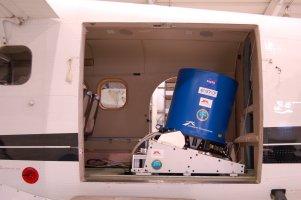The CO2LAS instrument was jointly developed by JPL and Lockheed Martin Coherent Technologies under funding from the NASA Earth Science Technology Office Instrument Incubator Program.
The instrument uses three continuous-wave (c.w.) Th:Ho:YLF lasers, one of which is used as an absolute frequency reference and is locked to a carbon dioxide absorption line in an internal gas cell using a phase modulation spectroscopy scheme. The remaining two lasers are offset frequency locked from the reference laser to provide the online and offline beams that are propagated through the atmosphere. The online and offline beams are expanded to an eye-safe level and transmitted to the ground where they are reflected back to the instrument, collected by the receive optics and detected. The use of the offset frequency-locking scheme together with the absolute frequency reference enables the absolute frequency of the online and offline lasers to be held to within 200 kHz of the desired values. The CO2LAS transceiver uses separate co-axial transmit/receive paths for each of the on-line and off-line channels.
A Doppler frequency shift is induced between the outgoing and return signals by pointing the transmit beams slightly off nadir. This frequency offset, together with a polarization transmit/receive architecture, ensures the receive signals are separated from the transmit signals by both polarization and frequency. The nominal Doppler offset is 15 MHz but this will vary as the aircraft attitude changes. The return signals on each channel are digitized and stored during flight for post-processing. Throughput of the data collection system was increased from ~8% to >20% between 2006 and 2007.
In order to ensure the instrument remains stable, the output power and frequency of all three lasers are monitored. The output power values for the online and offline lasers are used in the determination of the on-line and off-line absorption as part of the LAS measurement. The output power value for the reference laser is used primarily as a laser health status to check the integrity of the CO2 line center lock.
The electronics for the CO2LAS are mounted in two racks that typically mount to the seat rails of the host aircraft. One rack contains the control electronics for the transceiver system, laser controller, frequency locking electronics and provides the user interface for the overall system.
The second rack houses the chiller that supplies the optical transceiver with coolant and the signal processor which receives housekeeping data from the electronics rack, and digitizes, stores and analyzes the lidar return signal. The CO2LAS uses a Gigabit Ethernet system to distribute data across the system and to other computers that can be connected into the gigabit hub located in the back of one of the racks.


